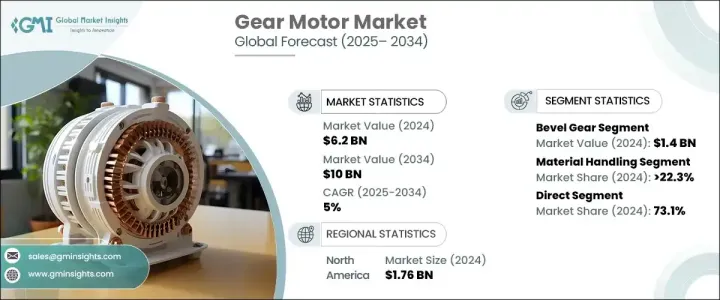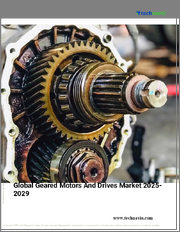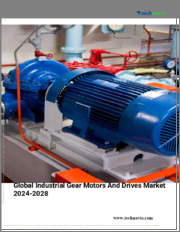
|
시장보고서
상품코드
1716456
기어 모터 시장 기회, 성장 촉진 요인, 산업 동향 분석, 예측(2025-2034년)Gear Motor Market Opportunity, Growth Drivers, Industry Trend Analysis, and Forecast 2025 - 2034 |
||||||
세계 기어 모터 시장은 2024년 62억 달러로 평가되었으며, 예측 기간 동안 CAGR 5%로, 2025년 64억 달러, 2034년 100억 달러로 성장할 것으로 예측됩니다.
성장의 원동력이 되고 있는 것은 발전에 대한 투자 증가와 산업계 전체에 있어서의 에너지 효율이 높은 솔루션의 채택 확대입니다. 화력 발전소, 수력 발전 시설에 많은 돈을 투자하고 있으며, 이들은 모두 동력 전달을 위해 기어 모터에 의존하고 있습니다. 풍력 터빈은 최적의 에너지 발전을 위해 피치 및 요 제어에 기어 모터를 사용하며, 태양광 발전소는 태양광 패널이 최대한의 태양광을 받도록 조정하는 트래킹 시스템에 기어 모터를 내장하고 있습니다. 수력 발전소와 화력 발전소는 또한 운영 효율성과 신뢰성을 높이기 위해 컨베이어, 터빈, 냉각 회로에 기어 모터를 사용합니다. 예지 보전 기능을 갖춘 IoT 대응 기어 모터 수요도 높아지고 있어 실시간으로 성능 감시를 가능하게 하고 발전 분야에서의 지속적인 성장을 뒷받침하고 있습니다.

2024년 베벨 기어 부문 매출은 14억 달러로 2034년까지 연평균 복합 성장률(CAGR)은 5.4%를 보일 것으로 예측되고 있습니다. 최소한의 에너지 손실로 작동하므로 다양한 전력 전송 시스템에서 선호하고 사용되고 있습니다. 산업계가 점점 스마트한 제조 방법을 채용해, 자동화를 통합함에 따라, 기어 모터는 효율적이고 신뢰성이 높은 오퍼레이션을 유지하는 데 필수적입니다.
| 시장 범위 | |
|---|---|
| 시작 연도 | 2024년 |
| 예측 연도 | 2025-2034년 |
| 시작 금액 | 62억 달러 |
| 예측 금액 | 100억 달러 |
| CAGR | 5% |
자재관리는 2024년 시장 점유율의 22.3% 이상을 차지했으며, 2034년까지 5%의 성장률을 보일 것으로 예상됩니다. 기계, 호이스트, 자동 창고 시스템과 같은 자재관리 용도에서 중요한 역할을 수행합니다. 이커머스의 성장과 창고 자동화의 광범위한 채택으로 인해 소재 이동을 간소화하기 위해 기어 모터가 장착된 현대 시스템 수요를 부추기고 있습니다. 또한 광업, 철강, 시멘트 등의 산업에서는 가혹한 조건에서 벌크 재료를 관리하기 위해 헤비 듀티 기어 모터가 도입되었습니다. 미국 경제 분석국의 2023년에 6.2% 증가한 인프라에 대한 정부 투자는 계속해서 선진적인 자재관리 시스템에 대한 수요를 촉진하여 기어 모터 시장을 더욱 활성화하고 있습니다.
직접 판매 채널은 2024년에 73.1%의 주요 점유율을 차지하며 비용 절감, 커스터마이징, 직접 기술 지원 등의 이점이 원동력이 되고 있습니다. 직접 판매는 또한 경쟁력 있는 가격 설정과 일괄 할인을 가능하게 하고, 자동차, 건설, 에너지 등의 업계에 이익을 가져오고 있습니다.
북미는 2024년 세계 시장 점유율의 약 28.3%를 차지했으며, 약 17억 6,000만 달러의 수익을 창출했습니다. 재생 에너지 프로젝트에 대한 투자가 증가하고 IoT 대응 스마트 모터의 채택으로 정밀 기어 모터 수요는 계속 증가하고 있습니다.
목차
제1장 조사 방법과 조사 범위
제2장 주요 요약
제3장 업계 인사이트
- 생태계 분석
- 공급자의 상황
- 가격 분석
- 기술과 혁신의 전망
- 주요 뉴스 및 이니셔티브
- 규제 상황
- 제조업체
- 판매자
- 세력에 대한 영향
- 성장 촉진요인
- 발전에 대한 투자 증가
- 세계의 제조 시설수 증가
- 업계의 잠재적 위험 및 과제
- 높은 설치 비용과 유지 보수 비용
- 복잡한 설계와 고급 기능
- 성장 촉진요인
- 성장 가능성 분석
- Porter's Five Forces 분석
- PESTEL 분석
제4장 경쟁 구도
- 소개
- 기업 점유율 분석
- 경쟁 포지셔닝 매트릭스
- 전략 전망 매트릭스
제5장 시장 추정 및 예측 : 유형별, 2021년-2034년
- 주요 동향
- 헬리컬 기어
- 유성 기어
- 베벨 기어
- 웜기어
- 스파기어
- 전동 기어
- 기타(PMDC, 컴팩트)
제6장 시장 추정 및 예측 : 정격 출력별, 2021년-2034년
- 주요 동향
- 7.5 kW 미만
- 7.5 kW-75 kW
- 75 kW 이상
제7장 시장 추정 및 예측 : 페이즈별, 2021년-2034년
- 주요 동향
- 1단
- 2단
- 3단
제8장 시장 추정 및 예측 : 토크별, 2021년-2034년
- 주요 동향
- 10000Nm 미만
- 10000Nm 이상
제9장 시장 추정 및 예측 : 최종 용도별, 2021년-2034년
- 주요 동향
- 자재관리
- 건설
- 발전
- 광업
- 음식
- 제조업
- 포장 및 라벨링
- 기타(풍력발전, 자동차, 해양)
제10장 시장 추정 및 예측 : 유통 채널별, 2021년-2034년
- 주요 동향
- 직접 판매
- 간접판매
제11장 시장 추정 및 예측 : 지역별, 2021년-2034년
- 주요 동향
- 북미
- 미국
- 캐나다
- 유럽
- 영국
- 독일
- 프랑스
- 이탈리아
- 스페인
- 러시아
- 아시아태평양
- 중국
- 인도
- 일본
- 호주
- 한국
- 라틴아메리카
- 브라질
- 멕시코
- 아르헨티나
- 중동 및 아프리카
- UAE
- 남아프리카
- 사우디아라비아
제12장 기업 프로파일
- Bauer Gear
- Bonfiglioli
- Emerson Electric
- Flender
- Harmonic Drive
- Jiangsu Guomao Reducer
- Nabtesco
- Nidec
- Portescap
- Power Build
- Regal Rexnord
- SEW Eurodrive
- Shanthi Gears
- Siemens
- Sumitomo Heavy Industries
The Global Gear Motor Market was valued at USD 6.2 billion in 2024 and is projected to grow from USD 6.4 billion in 2025 to USD 10 billion by 2034, reflecting a CAGR of 5%. The growth is driven by rising investments in power generation and increased adoption of energy-efficient solutions across industries. As global energy consumption surges, governments and private sector players are heavily investing in renewable energy, thermal power plants, and hydroelectric facilities, all of which rely on gear motors for power transmission. Wind turbines use gear motors for pitch and yaw control, ensuring optimal energy generation, while solar power plants integrate them into tracking systems to adjust solar panels for maximum sunlight exposure. Hydroelectric and thermal plants also use gear motors in conveyors, turbines, and cooling circuits to enhance operational efficiency and reliability. The demand for IoT-enabled gear motors with predictive maintenance capabilities is also rising, enabling real-time performance monitoring and driving sustained growth in the power generation sector.

In 2024, the bevel gear segment generated USD 1.4 billion in revenue and is expected to grow at a CAGR of 5.4% through 2034. Bevel gear motors remain dominant due to their efficiency, flexibility, and ability to transmit power at various angles. These motors are widely used in automotive, material handling, mining, and industrial automation applications due to their compact size and high torque capabilities. They operate with minimal energy loss, making them a preferred choice in numerous power transmission systems. As industries increasingly adopt smart manufacturing practices and integrate automation, gear motors are essential for maintaining efficient and reliable operations. According to the U.S. Department of Energy, industrial motors, including gear motors, account for nearly 70% of electricity consumption in manufacturing plants, underscoring the importance of energy-efficient designs.
| Market Scope | |
|---|---|
| Start Year | 2024 |
| Forecast Year | 2025-2034 |
| Start Value | $6.2 Billion |
| Forecast Value | $10 Billion |
| CAGR | 5% |
Material handling accounted for over 22.3% of the market share in 2024 and is expected to grow at a rate of 5% until 2034. Gear motors play a crucial role in material handling applications, including conveyors, cranes, hoists, and automated storage systems used across logistics, warehousing, and manufacturing sectors. The growth of e-commerce and the widespread adoption of warehouse automation have fueled the demand for modern systems equipped with gear motors to streamline material movement. Additionally, heavy-duty gear motors are deployed in industries such as mining, steel, and cement to manage bulk materials under challenging conditions. Government investments in infrastructure, which rose by 6.2% in 2023 as per the U.S. Bureau of Economic Analysis, continue to drive demand for advanced material handling systems, further boosting the gear motor market.
The direct distribution channel held a major share of 73.1% in 2024, driven by the advantages of cost reduction, customization, and direct technical support. Manufacturers prefer direct sales to maintain control over product quality and offer tailored solutions to industries with critical accuracy and reliability requirements, such as robotics, aerospace, and medical equipment. Direct sales also allow for competitive pricing and bulk discounts, benefiting industries such as automotive, construction, and energy. The rise of online portals and direct sourcing platforms has simplified purchasing and enabled real-time inventory monitoring, further enhancing the efficiency of direct sales channels.
North America accounted for around 28.3% of the global market share in 2024, generating approximately USD 1.76 billion in revenue. The region's growth is driven by the increasing demand for industrial automation, robotics, and energy-efficient solutions across manufacturing, food processing, and logistics industries. With rising investments in renewable energy projects and the adoption of IoT-enabled smart motors, the demand for precision gear motors continues to increase. Europe also exhibits strong market growth, particularly in countries such as Germany, France, and Italy, where strict energy efficiency regulations and a focus on sustainability drive demand for high-performance gear motors.
Table of Contents
Chapter 1 Methodology & Scope
- 1.1 Research design
- 1.1.1 Research Approach
- 1.1.2 Data collection methods
- 1.2 Base estimates and calculations
- 1.2.1 Base year calculation
- 1.2.2 Key trends for market estimates
- 1.3 Forecast model
- 1.4 Primary research & validation
- 1.4.1 Primary sources
- 1.4.2 Data mining sources
- 1.5 Market definitions
Chapter 2 Executive Summary
- 2.1 Industry synopsis, 2021 - 2034
Chapter 3 Industry Insights
- 3.1 Industry ecosystem analysis
- 3.2 Supplier landscape
- 3.3 Pricing analysis
- 3.4 Technology & innovation landscape
- 3.5 Key news & initiatives
- 3.6 Regulatory landscape
- 3.7 Manufacturers
- 3.8 Distributors
- 3.9 Impact on forces
- 3.9.1 Growth drivers
- 3.9.1.1 Rising investment in power generation
- 3.9.1.2 Increase in the number of manufacturing facilities globally
- 3.9.2 Industry pitfalls & challenges
- 3.9.2.1 High Installation and Maintenance Cost
- 3.9.2.2 Complex designs or advanced features
- 3.9.1 Growth drivers
- 3.10 Growth potential analysis
- 3.11 Porter's analysis
- 3.12 PESTEL analysis
Chapter 4 Competitive Landscape, 2024
- 4.1 Introduction
- 4.2 Company market share analysis
- 4.3 Competitive positioning matrix
- 4.4 Strategic outlook matrix
Chapter 5 Market Estimates & Forecast, By Type, 2021 - 2034 ($Bn) (Thousand Units)
- 5.1 Key trends
- 5.2 Helical gear
- 5.3 Planetary gear
- 5.4 Bevel gear
- 5.5 Worm gear
- 5.6 Spur gear
- 5.7 Electric gear
- 5.8 Others (PMDC, compact)
Chapter 6 Market Estimates & Forecast, By Rated Power, 2021 - 2034 ($Bn) (Thousand Units)
- 6.1 Key trends
- 6.2 Up to 7.5 kW
- 6.3 7.5 kW to 75 kW
- 6.4 Above 75kW
Chapter 7 Market Estimates & Forecast, By Phase, 2021 - 2034 ($Bn) (Thousand Units)
- 7.1 Key trends
- 7.2 Single
- 7.3 Double
- 7.4 Three
Chapter 8 Market Estimates & Forecast, By Torque, 2021 - 2034 ($Bn) (Thousand Units)
- 8.1 Key trends
- 8.2 up to 10000 Nm
- 8.3 above 10000 Nm
Chapter 9 Market Estimates & Forecast, By End Use, 2021 - 2034 ($Bn) (Thousand Units)
- 9.1 Key trends
- 9.2 Material handling
- 9.3 Construction
- 9.4 Power generation
- 9.5 Mining
- 9.6 Food & beverage
- 9.7 Manufacturing industry
- 9.8 Packaging and labeling
- 9.9 Other (wind power, automotive, marine)
Chapter 10 Market Estimates & Forecast, By Distribution Channel, 2021 - 2034 ($Bn) (Thousand Units)
- 10.1 Key trends
- 10.2 Direct sales
- 10.3 Indirect sales
Chapter 11 Market Estimates & Forecast, By Region, 2021 - 2034 ($Bn) (Thousand Units)
- 11.1 Key trends
- 11.2 North America
- 11.2.1 U.S.
- 11.2.2 Canada
- 11.3 Europe
- 11.3.1 UK
- 11.3.2 Germany
- 11.3.3 France
- 11.3.4 Italy
- 11.3.5 Spain
- 11.3.6 Russia
- 11.4 Asia Pacific
- 11.4.1 China
- 11.4.2 India
- 11.4.3 Japan
- 11.4.4 Australia
- 11.4.5 South Korea
- 11.5 Latin America
- 11.5.1 Brazil
- 11.5.2 Mexico
- 11.5.3 Argentina
- 11.6 MEA
- 11.6.1 UAE
- 11.6.2 South Africa
- 11.6.3 Saudi Arabia
Chapter 12 Company Profiles
- 12.1 Bauer Gear
- 12.2 Bonfiglioli
- 12.3 Emerson Electric
- 12.4 Flender
- 12.5 Harmonic Drive
- 12.6 Jiangsu Guomao Reducer
- 12.7 Nabtesco
- 12.8 Nidec
- 12.9 Portescap
- 12.10 Power Build
- 12.11 Regal Rexnord
- 12.12 SEW Eurodrive
- 12.13 Shanthi Gears
- 12.14 Siemens
- 12.15 Sumitomo Heavy Industries



















